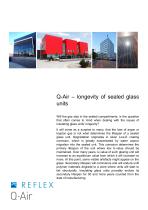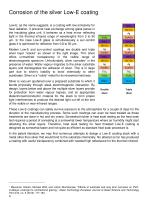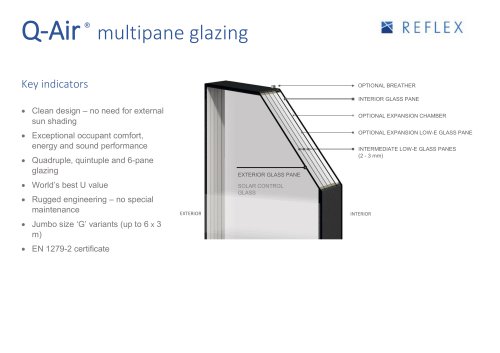
Catalog excerpts

Q-Air – longevity of sealed glass units Will the gas stay in the sealed compartments, is the question that often comes to mind when dealing with the issues of insulating glass units’ longevity? It will come as a surprise to many, that the loss of argon or krypton gas is not what determines the lifespan of a sealed glass unit. Degradation originates in silver Low-E coating corrosion, which is greatly exacerbated by water vapour migration into the sealed unit. This corrosion determines the primary lifespan of the unit where low U-value should be maintained. Over many years, U-value of such glazing unit will increase to an equilibrium value from which it will increase no more. At this point, some visible artefacts might appear on the glass. Secondary lifespan will commence and will endure until polymer materials degrade to a point where units will start to fail structurally. Insulating glass units provably endure its secondary lifespan for 50 and more years counted from the date of manufacturing
Open the catalog to page 1
Table of contents The centre of glass Ug value Corrosion of the silver Low-E coating Water vapour ingress Expected primary lifespan comparisons
Open the catalog to page 2
The centre of glass Ug value Heat transfer through the glazed unit consists of heat radiation exchange among the glass panes and gas-gap related heat transfer combining conduction and convection. Q-Air reduces heat transfer using low thermal conductivity gas, which in most applications is argon and through the application of Low-E coatings, which mitigates heat radiation. As the glass unit ages, loss of gas and degradation of Low-E coating will gradually increase the Ug value of the glass unit. The calculated table below shows estimated approximate timeline of these changes and their...
Open the catalog to page 3
Corrosion of the silver Low-E coating Low-E, as the name suggests, is a coating with low emissivity for heat radiation. It prevents heat exchange among glass panes in the insulating glass unit. It behaves as a heat mirror reflecting light in the thermal infrared range of wavelengths from 3 to 50 µm. In the case Low-E glass is simultaneously a sun-control glass it is optimized for reflection from 0.8 to 50 µm. Modern Low-E and sun-control coatings are double and triple silver layer “stacks” as shown in the right image. Thin silver offers unmatched transparency in the visible range of...
Open the catalog to page 4
Water vapour ingress From glazing engineering standpoint, aluminium, stainless steel and float glass are water vapour impermeable. These materials exhibit only trace permeability relevant to high and ultrahigh vacuum applications where even trace quantities must be accounted. Atmospheric water vapour slowly migrates into the sealed insulating glass unit through the polymeric seals where it slowly saturates the desiccant. It is the purpose of desiccant, residing in the spacers to uptake the water as it passes through the sealant. Note, that desiccant does not remove vapour from the glass...
Open the catalog to page 5
This would be the end of story if we were talking about double-pane glass units. In the multipane glass configurations, however, there is always at least one glass pane that is out of contact with the exterior. In the summer sun those middle panes heat-up considerably. Sealant and hybrid spacer temperature limit quad pane unit 5-pane unit 6-pane unit Q-Air 5 External pane Pane number In the diagram above temperatures of individual glass panes in contact with the primary seal are shown for various unsophisticated multipane glass arrangements and the Q-Air as reference. Q-Air uses two...
Open the catalog to page 6
Expected average primary lifespan comparisons As already indicated above, the exact lifespan of a glass unit is a mixture of climatic, engineering design and manufacturing quality parameters. With multipane glazing, it is the management of insolated primary seal that is less known and usually neglected by suppliers of novel triple and quadruple glass units. The EN 1279 certificate is meaningless in this respect as it tests for double glazing temperature conditions. In the table below are given expected primary life-spans of wellengineered glass units. Note that primary lifespan does not...
Open the catalog to page 7All REFLEX catalogs and technical brochures
-
REFLEX
40 Pages
-
Q-Air program
2 Pages
-
Sound insulating glas
1 Pages
-
Sun protection glass
1 Pages
-
Thermal insulating glass
1 Pages








